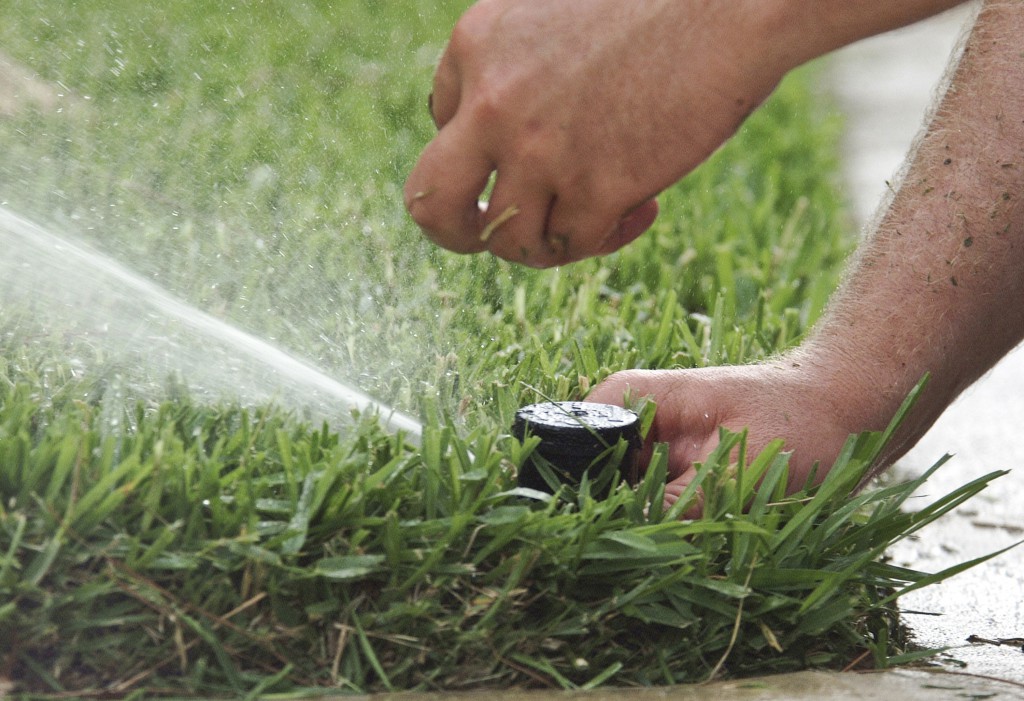
Setting the sprinkler head for an irrigation system. UF/IFAS Photo: Josh Wickham
Lawns and landscapes require water to flourish and provide the green surroundings desired around homes and recreational areas. Often nature provides water for the landscape in the form of rain, but that is not always adequate. Turf and ornamental plants in the establishment stage need supplemental irrigation during hotter months, especially in the sandy soils of northwest Florida, which can dry out at a rapid pace. February is typically a time when very little supplemental irrigation water is needed because most of the desired landscape plants and grasses do not use much water in the cooler temperatures. The warmth of spring and the heat of summer are around the corner and preparations should be made now to ensure that irrigation systems are working properly before being needed. Here are a few things to think about when prepping irrigation systems for spring:
- Maintain, Repair, or Replace the Rotors, Nozzles, and Heads. Many sprinkler heads get damaged over time from riding lawn mowers, utility workers, vehicles, or other causes. To avoid having a geyser in the irrigation zone, it is a good idea to test run the system to make sure the rotor and heads are working properly and the nozzles have not been knocked loose. Many times broken rotor or spray heads can be replaced simply by taking the interior mechanical parts out and replacing them with new parts. This may not even require digging! Sometimes repairs are as simple as replacing a filter or spray nozzle that has popped off over time.
- Calibrate the system to provide 1/2 inch to 3/4 inch during an irrigation event. Many Florida homeowners and horticultural professionals apply too much or too little water while irrigating. Most do not even know how much irrigation water is being applied. It is important to calibrate the irrigation system to apply only 1/2 inch to 3/4 inch of water during an irrigation event to promote a healthy lawn and landscape. To little water will stress the plants while too much water may promote disease and insect problems. Irrigating improperly may also cause environmental issues, from soil and fertilizer runoff, to develop. Watch this short video on irrigation calibration.
- Inspect and make sure the Rain Shutoff Device is working properly. In Florida, it is state law to have a rain shutoff device on an automatic irrigation system. Most systems have a device installed that utilizes a small cork disc that expands when wet and physically clicks a button to tell the system to skip the next automatic cycle. As the cork degrades over time, it will cause system malfunction and should be replaced periodically. It is best to skip using an automatic timer and instead watch the weather and the plants for symptoms of drought stress. If an automatic timer is used, a functioning rain shutoff device is essential for proper irrigation management. Other types of shutoff devices are available as well.
The following University of Florida / IFAS publications contains more information on proper irrigation management for landscapes:
Residential Irrigation System Rainfall Shutoff Devices
Using Reclaimed Water for Landscape Irrigation
Florida Lawn Handbook: Watering Efficiently
- Growing Healthy Palms Workshop - July 20, 2016
- It is time to monitor for Rose Rosette Disease in Florida - May 24, 2016
- Too Late yet Too Early - March 24, 2016